When does the Rapture happen?

The timing of the "Rapture" relative to other end-time events is a subject of great debate. But what is the Rapture? When people talk about the Rapture, they usually are referring to this event, described by Paul.
For the Lord himself will descend from heaven with a cry of command, with the voice of an archangel, and with the sound of the trumpet of God. And the dead in Christ will rise first. Then we who are alive, who are left, will be caught up together with them in the clouds to meet the Lord in the air, and so we will always be with the Lord. Therefore encourage one another with these words. (1 Thessalonians 4:16-17)
Debates about the timing of this event are centered around the final 7 years of history prior to the establishment of Christ's reign of prosperity and peace on the earth.

These terms are abbreviations for the following:
Pretribulationism - The Rapture happens before the 7-year period prior to Christ's reign on earth.
Midtribulationism - The Rapture happens halfway through the 7-year period prior to Christ's reign on earth.
Posttribulationism - The Rapture happens at the end of the 7-year period prior to Christ's reign on earth.
These three positions remain quite gridlocked. In particular, the Pre-Trib and Post-Trib views have conclusive arguments against each other. This article explains a fourth position, called the PreWrath Rapture. Popularized in the 1990's, this position neatly harmonizes all of the Bible texts in question without forcing or straining. (1)
Daniel's Timeline
Daniel talks about a time when the Antichrist makes a 7-year treaty with Israel, and possibly many others. However, halfway through this 7-year treaty, the Antichrist is revealed as the "abomination of desolation."
And he shall make a strong covenant with many for one week, and for half of the week he shall put an end to sacrifice and offering. And on the wing of abominations shall come one who makes desolate, until the decreed end is poured out on the desolator. (Daniel 9:27)
"Abomination of desolation" is a technical term for the placement of an idol in the Jewish temple. One of these happened in 168 B.C. when Antiochus IV Epiphanes placed an idol of Zeus on the temple altar. (2, 3, 4, 5) However, Jesus says that an "abomination of desolation" will happen in the end-times, just prior to his return. Daniel, Jesus, and Paul strongly imply that this idol will be a person in the temple, not merely a statue. Click here to for a more comprehensive discussion of the abomination of desolation.
Daniel 9:27 is part of the broader "70 weeks" prophecy.
Seventy weeks are decreed about your people and your holy city, to finish the transgression, to put an end to sin, and to atone for iniquity, to bring in everlasting righteousness, to seal both vision and prophet, and to anoint a most holy place. (Daniel 9:24)
By the end of the last 7 years, the above six goals must be finished. "Everlasting righteousness" refers to the reign of Christ in the Millennium. "Anoint a most holy place" likely refers to the establishment of the Temple for the Millennium, where Christ will rule (Ezek. 40-45). Finally, the whole prophecy is for "your people and your holy city." Therefore, Jesus must be reigning in Jerusalem by the end of this final week of years.
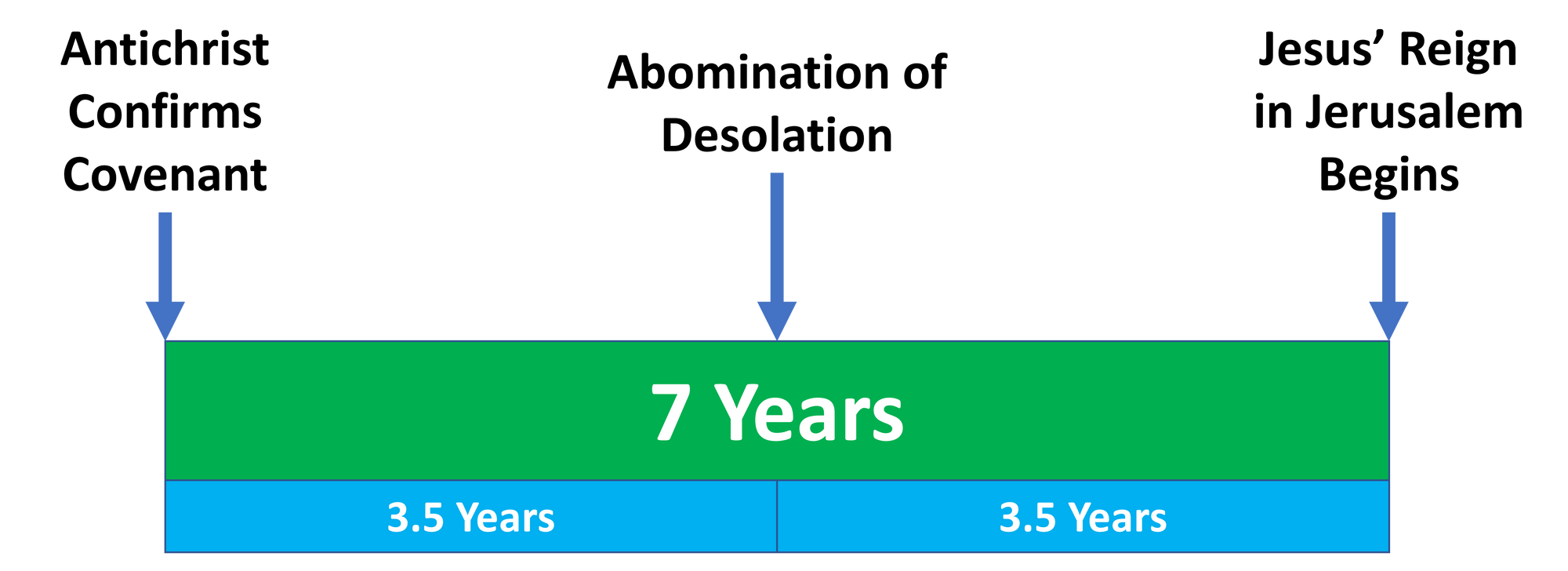
Jesus' Timeline
In Matthew 24, Jesus talks about the events that happen before and after the abomination of desolation:
For nation will rise against nation, and kingdom against kingdom, and there will be famines and earthquakes in various places. All these are but the beginning of the birth pains.
“Then they will deliver you up to tribulation and put you to death, and you will be hated by all nations for my name's sake. And then many will fall away and betray one another and hate one another. And many false prophets will arise and lead many astray. And because lawlessness will be increased, the love of many will grow cold. But the one who endures to the end will be saved. And this gospel of the kingdom will be proclaimed throughout the whole world as a testimony to all nations, and then the end will come.
“So when you see the abomination of desolation spoken of by the prophet Daniel, standing in the holy place (let the reader understand),then let those who are in Judea flee to the mountains. Let the one who is on the housetop not go down to take what is in his house, and let the one who is in the field not turn back to take his cloak. And alas for women who are pregnant and for those who are nursing infants in those days! Pray that your flight may not be in winter or on a Sabbath. For then there will be great tribulation, such as has not been from the beginning of the world until now, no, and never will be. And if those days had not been cut short, no human being would be saved. But for the sake of the elect those days will be cut short. (Matthew 24:7-23)
When does the Great Tribulation end? Jesus answers this question as well:
“Immediately after the tribulation of those days the sun will be darkened, and the moon will not give its light, and the stars will fall from heaven, and the powers of the heavens will be shaken. Then will appear in heaven the sign of the Son of Man, and then all the tribes of the earth will mourn, and they will see the Son of Man coming on the clouds of heaven with power and great glory. And he will send out his angels with a loud trumpet call, and they will gather his elect from the four winds, from one end of heaven to the other. (Matthew 24:29-31)
Almost all theologians assume that the "coming of the Son of Man" happens at the end of the 7-years, regardless of their Rapture view. Pre-Trib and Mid-Trib followers say that the Rapture is not discussed in Matthew 24. They argue that this is a speech towards the Jewish people, not the Church. On their view, the coming of the son of Man happens at the end of the 7-year period. (6) Similarly, those holding a Post-Trib view would say that the coming of the Son of Man and the Rapture are the same event, also happening at the end of the 7 years.
But is this true? Jesus goes on, to describe the time of the coming of the Son of Man:
But concerning that day and hour no one knows, not even the angels of heaven, nor the Son, but the Father only. For as were the days of Noah, so will be the coming of the Son of Man. For as in those days before the flood they were eating and drinking, marrying and giving in marriage, until the day when Noah entered the ark, and they were unaware until the flood came and swept them all away, so will be the coming of the Son of Man. [...] But know this, that if the master of the house had known in what part of the night the thief was coming, he would have stayed awake and would not have let his house be broken into. Therefore you also must be ready, for the Son of Man is coming at an hour you do not expect. (Matthew 24:36-39; 43-44)
In conversation, people usually use this language to describe the Rapture. However, Jesus uses this robber-at-night language to describe the coming of the Son of Man on the clouds. Yet according to theologians, the coming of the son of man happens approximately 3 1/2 years after the abomination of desolation, at the end of the 7-year period.
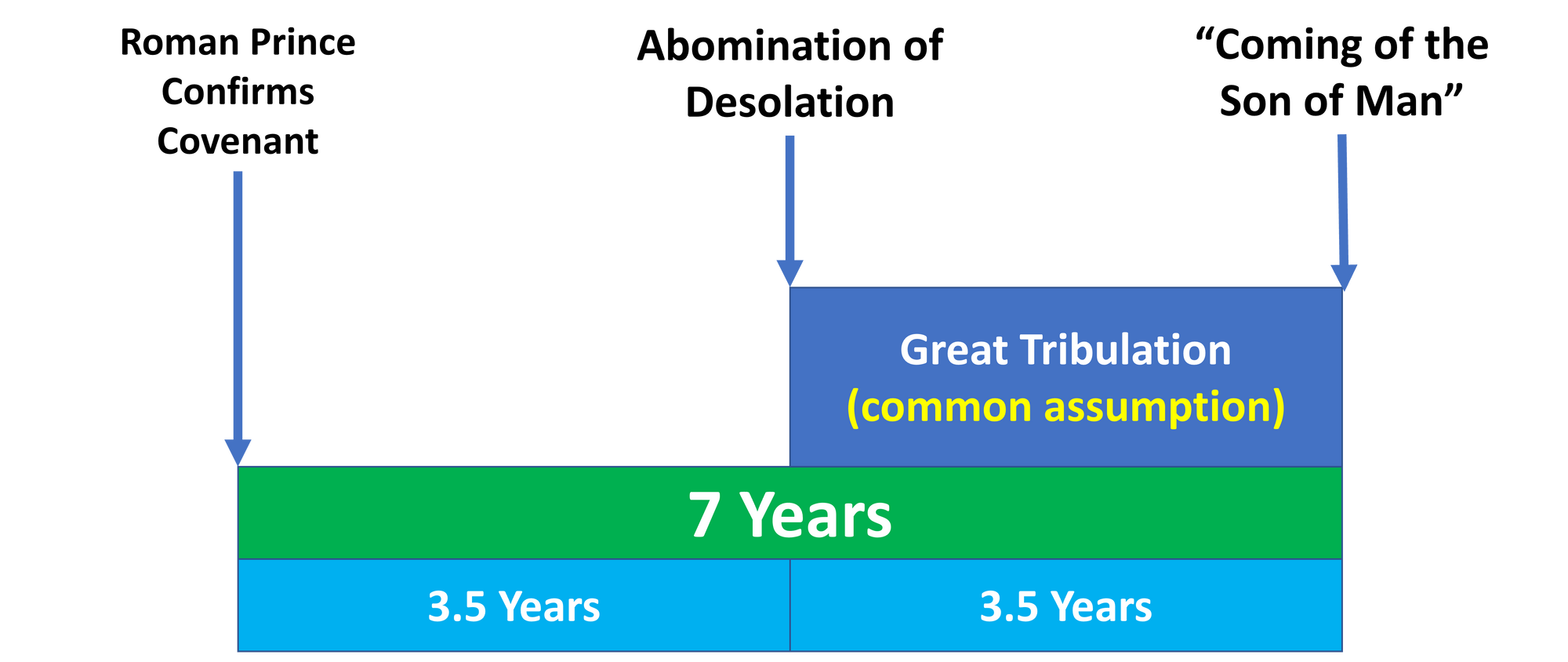
The text indicates that the majority view is incorrect. The coming of the son of man happens at a sudden and unexpected time after the abomination of desolation. It does not happen at a predictable time 3 1/2 years after that. Furthermore, Jesus does not say that the "Great Tribulation" is 3 1/2 years. On the contrary, he says it will be "cut short" for the sake of the elect. (Matt. 24:22) Therefore, the length of the Great Tribulation is unknown, since it is not specified by the text.
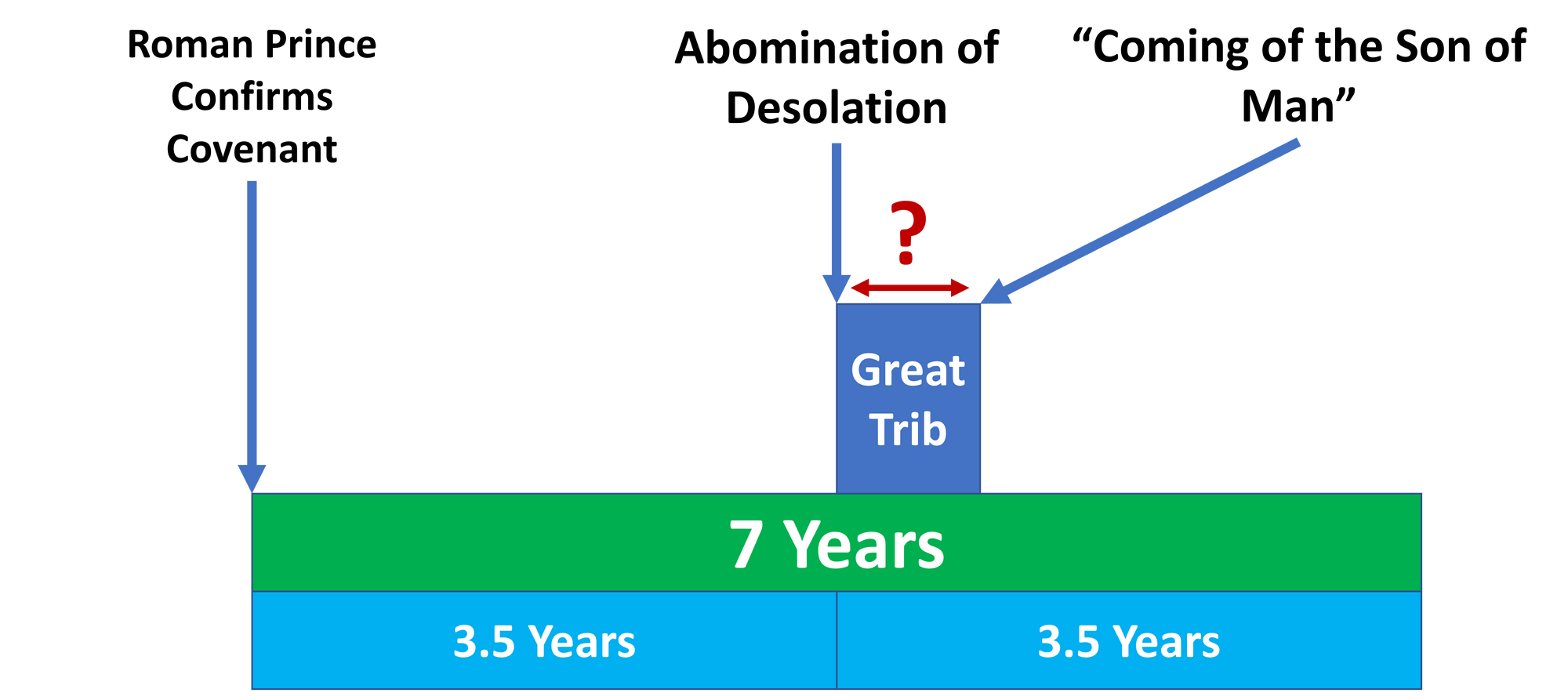
Jesus compares the signs of his coming to "birth pains" (Matt. 24:7). Birth pains start off less frequent and less painful. However, as the time of delivery draws near, the contractions get more frequent and intense. Finally, they culminate in all out agony right before the baby is born. The coming of the Son of Man on the clouds is comparable to the joyous birth of the baby. (7) The signs beforehand are analogous to the contractions, which increase in frequency and severity over time.
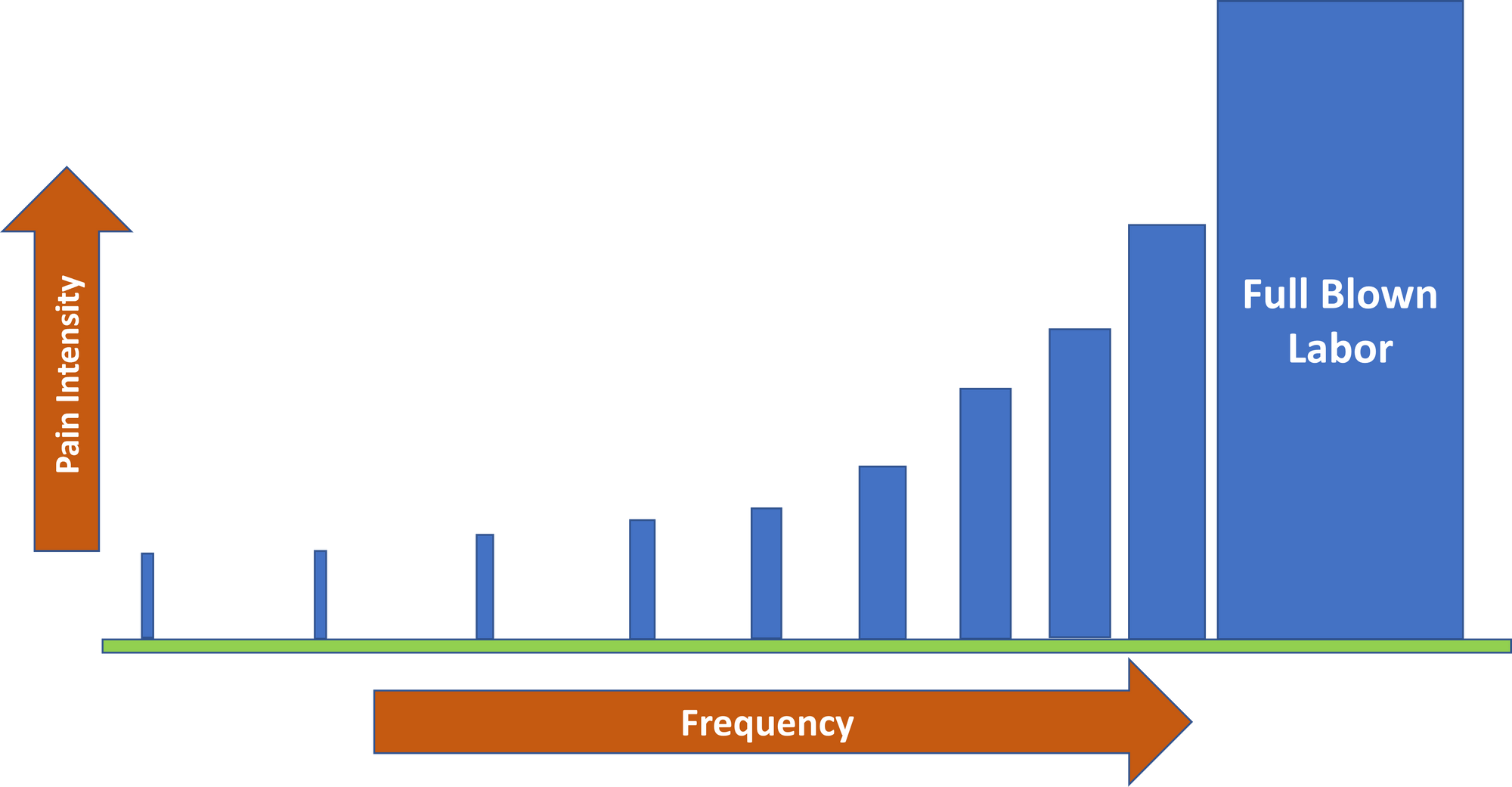
This is why the chart below has the first signs of Christ's coming spaced apart. The latter, more severe signs, are shorter and closer to the Second Coming. This revised understanding allows us to superimpose the timeline Jesus gives us onto the timeline we find in Daniel.
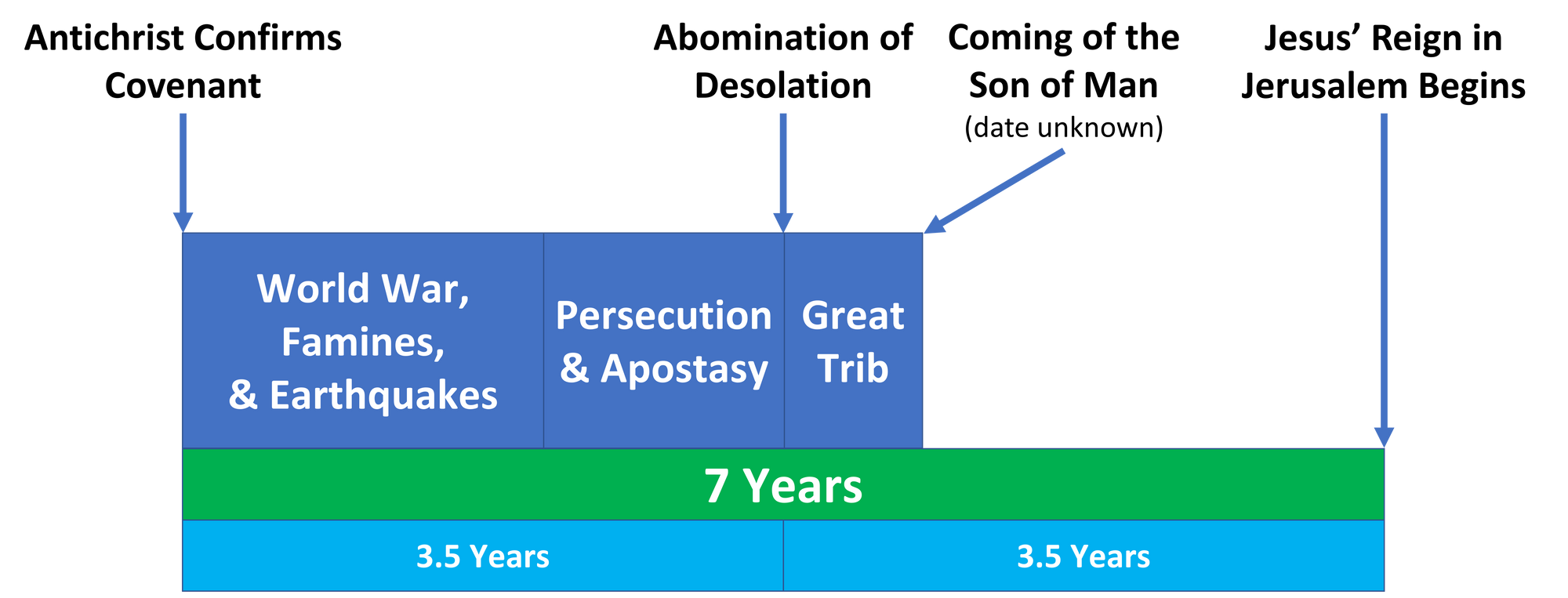
Paul's Timeline
How does this square with what Paul says about the "coming of the Lord"?
But we do not want you to be uninformed, brothers, about those who are asleep, that you may not grieve as others do who have no hope. For since we believe that Jesus died and rose again, even so, through Jesus, God will bring with him those who have fallen asleep. For this we declare to you by a word from the Lord, that we who are alive, who are left until the coming of the Lord, will not precede those who have fallen asleep. For the Lord himself will descend from heaven with a cry of command, with the voice of an archangel, and with the sound of the trumpet of God. And the dead in Christ will rise first. Then we who are alive, who are left, will be caught up together with them in the clouds to meet the Lord in the air, and so we will always be with the Lord.Therefore encourage one another with these words.
Now concerning the times and the seasons, brothers, you have no need to have anything written to you. For you yourselves are fully aware that the day of the Lord will come like a thief in the night. While people are saying, “There is peace and security,” then sudden destruction will come upon them as labor pains come upon a pregnant woman, and they will not escape. (1 Thessalonians 4:13 - 5:3)
Notice how Paul's description of the "coming of the Lord" is very similar to the "coming of the Son of Man" in Matthew 24:
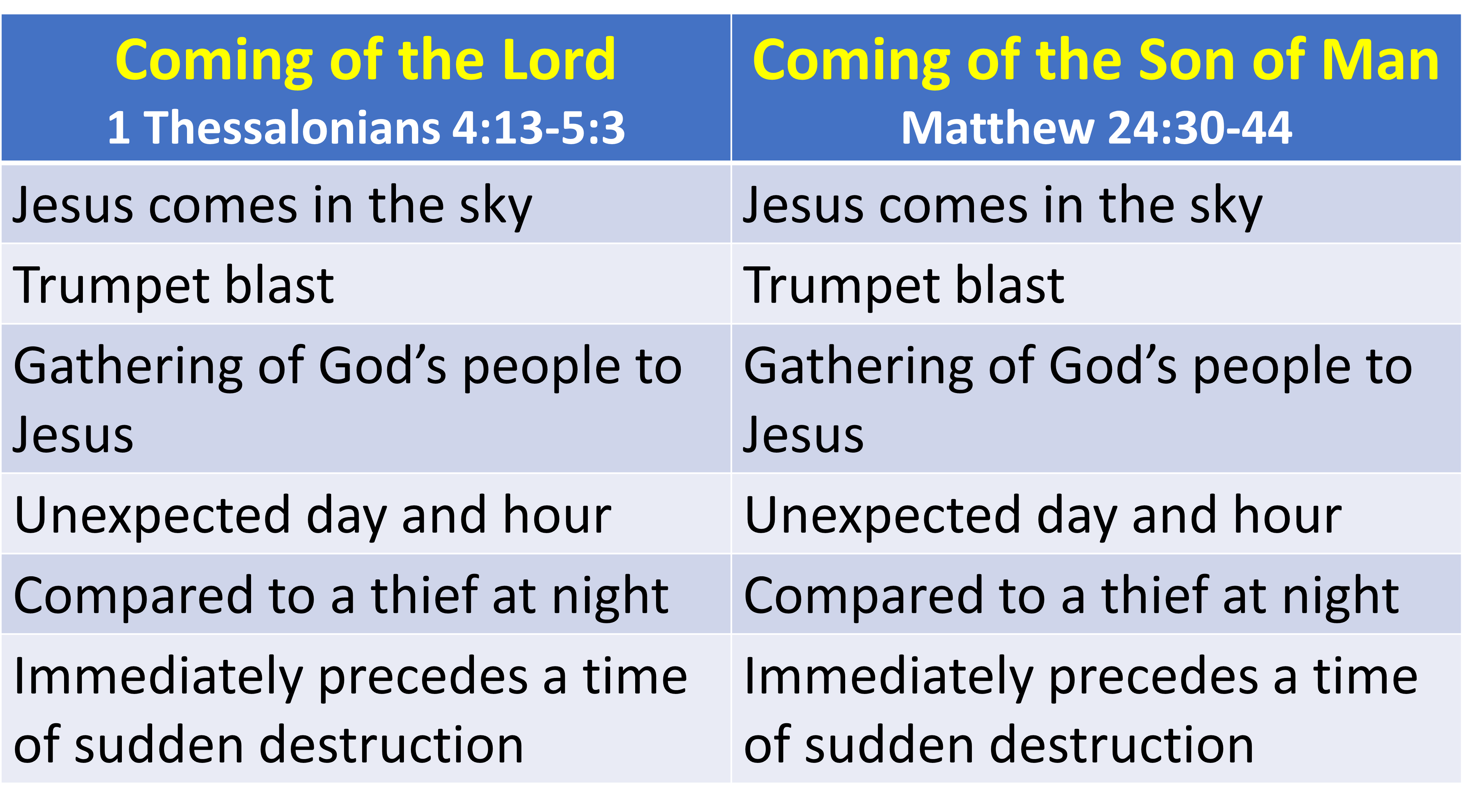
Paul believes the "coming of the Lord" (Rapture) is synonymous with the "Day of the Lord." He equates these events in two separate places.
In 2 Thessalonians 2, Paul equates the "day of the Lord" with Christ's coming to gather his believers:
Now concerning the coming of our Lord Jesus Christ and our being gathered together to him, we ask you, brothers, not to be quickly shaken in mind or alarmed, either by a spirit or a spoken word, or a letter seeming to be from us, to the effect that the day of the Lord has come. (2 Thessalonians. 2:1-2)
After describing the Rapture in 1 Thessalonians 4, Paul says:
Now concerning the times and the seasons, brothers, you have no need to have anything written to you. For you yourselves are fully aware that the day of the Lord will come like a thief in the night. While people are saying, “There is peace and security,” then sudden destruction will come upon them as labor pains come upon a pregnant woman, and they will not escape. (1 Thessalonians. 5:1-3)
Paul tells us that the day of the Lord brings the Rapture for believers. However, it brings "sudden destruction" for the unbelievers.
This is a term found throughout the Old Testament which describes a time of destruction and wrath.
Wail, for the day of the Lord is near; as destruction from the Almighty it will come! (Isaiah 13:6)
Behold, the day of the Lord comes, cruel, with wrath and fierce anger, to make the land a desolation and to destroy its sinners from it. (Isaiah 13:9)
For the day is near, the day of the Lord is near; it will be a day of clouds, a time of doom for the nations. (Ezekiel 30:3)
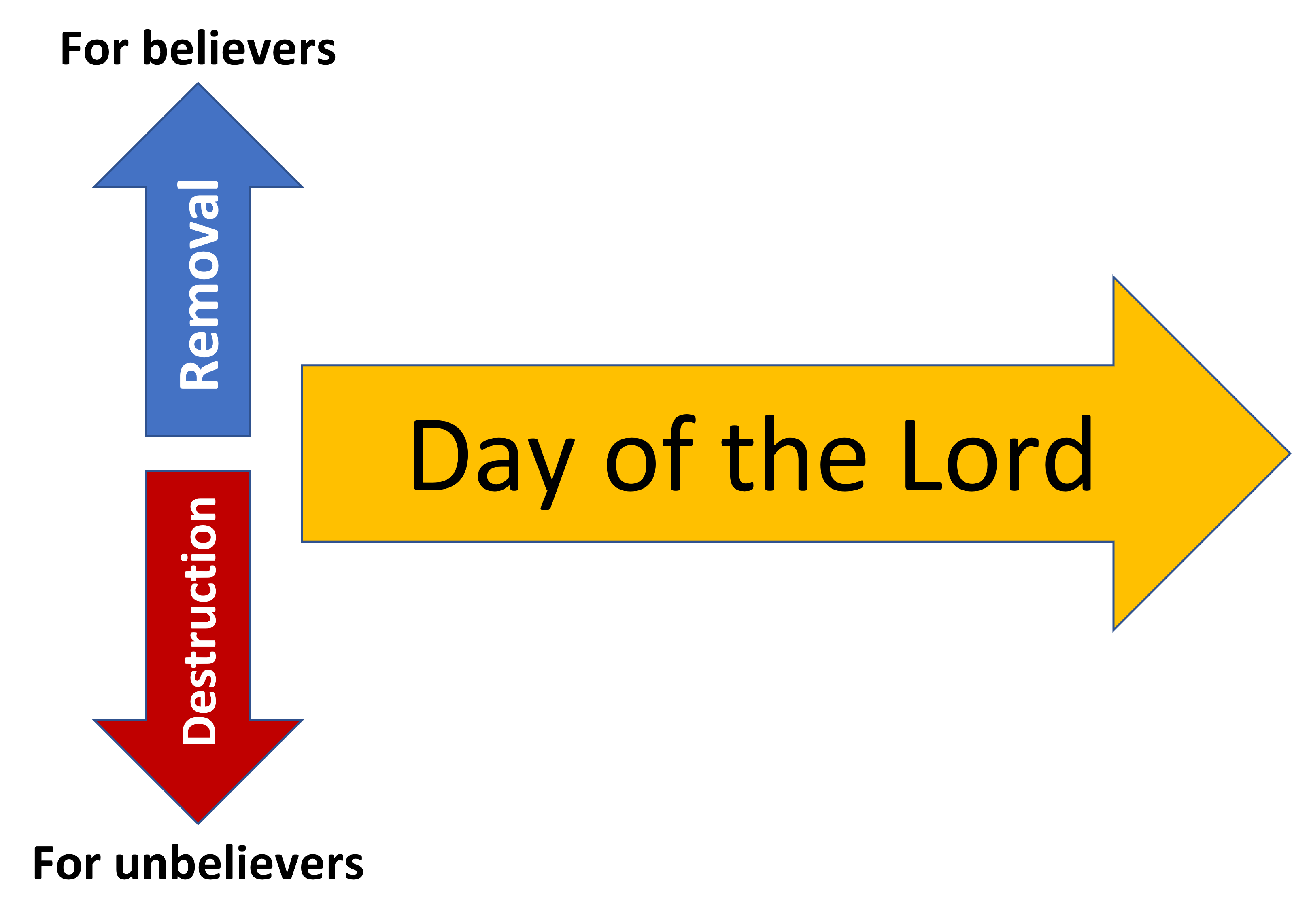
In 2 Thessalonians, Paul clarifies some things that have to happen before the "Day of the Lord."
Now concerning the coming of our Lord Jesus Christ and our being gathered together to him, we ask you, brothers,not to be quickly shaken in mind or alarmed, either by a spirit or a spoken word, or a letter seeming to be from us, to the effect that the day of the Lord has come. Let no one deceive you in any way. For that day will not come, unless the rebellion comes first, and the man of lawlessness is revealed, the son of destruction, who opposes and exalts himself against every so-called god or object of worship, so that he takes his seat in the temple of God, proclaiming himself to be God. Do you not remember that when I was still with you I told you these things? And you know what is restraining him now so that he may be revealed in his time. For the mystery of lawlessness is already at work. Only he who now restrains it will do so until he is out of the way. And then the lawless one will be revealed, whom the Lord Jesus will kill with the breath of his mouth and bring to nothing by the appearance of his coming. (2 Thessalonians 2:1-7)
The list of signs given here are very similar to what Jesus says precedes the coming of the Son of Man.
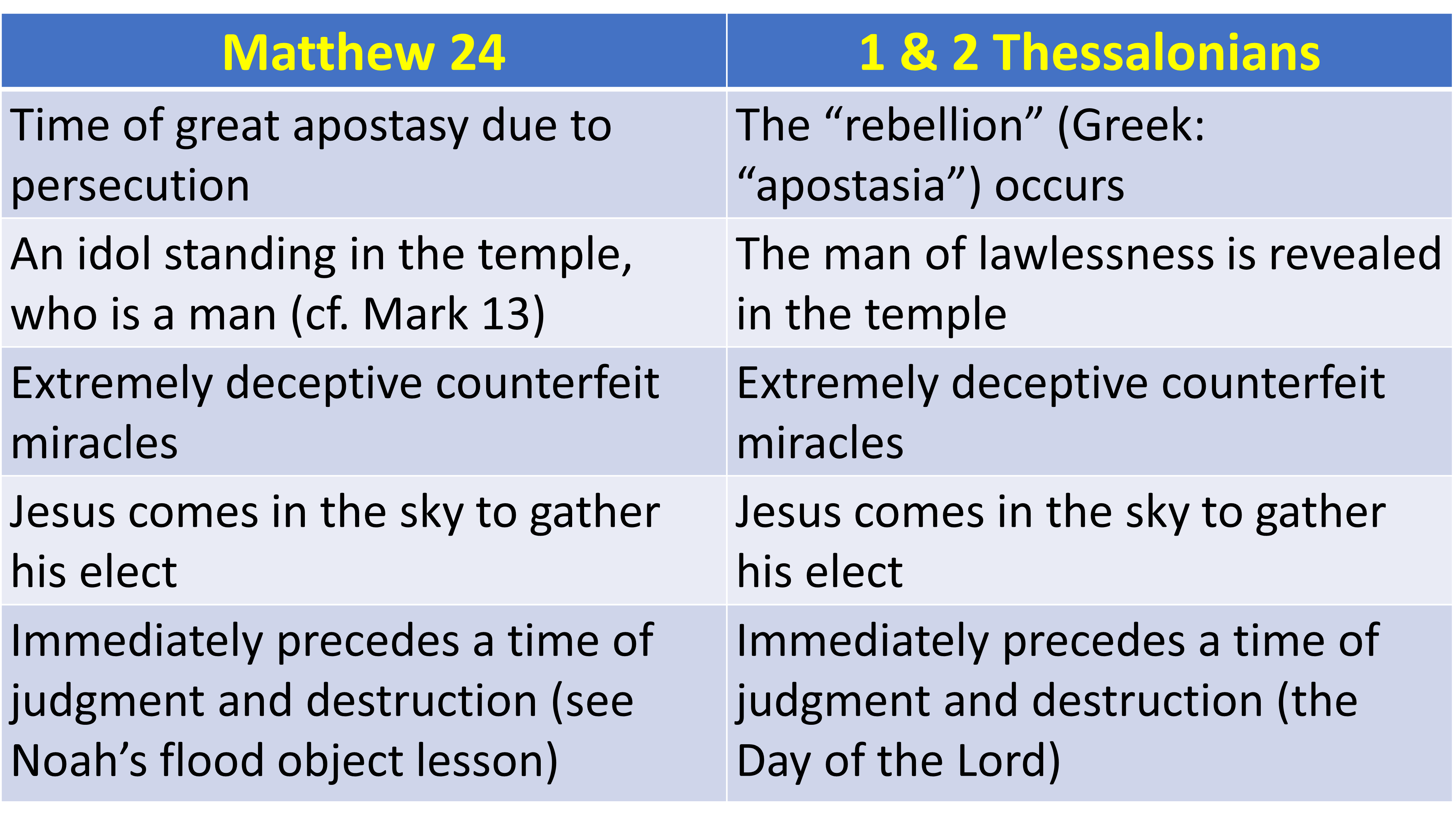
(8)
It becomes clear then, that the Antichrist's revealing in the temple is the same as the abomination of desolation that both Daniel and Jesus talk about. In addition to Paul and Daniel, Jesus implies that this end-times idol will be a person in the temple, not merely a statue.
But when you see the abomination of desolation standing where he ought not to be (let the reader understand), then let those who are in Judea flee to the mountains. (Mark 13:14)
As a result, we can superimpose Paul's timeline from 1 & 2 Thessalonians onto Jesus' timeline in Matthew 24.
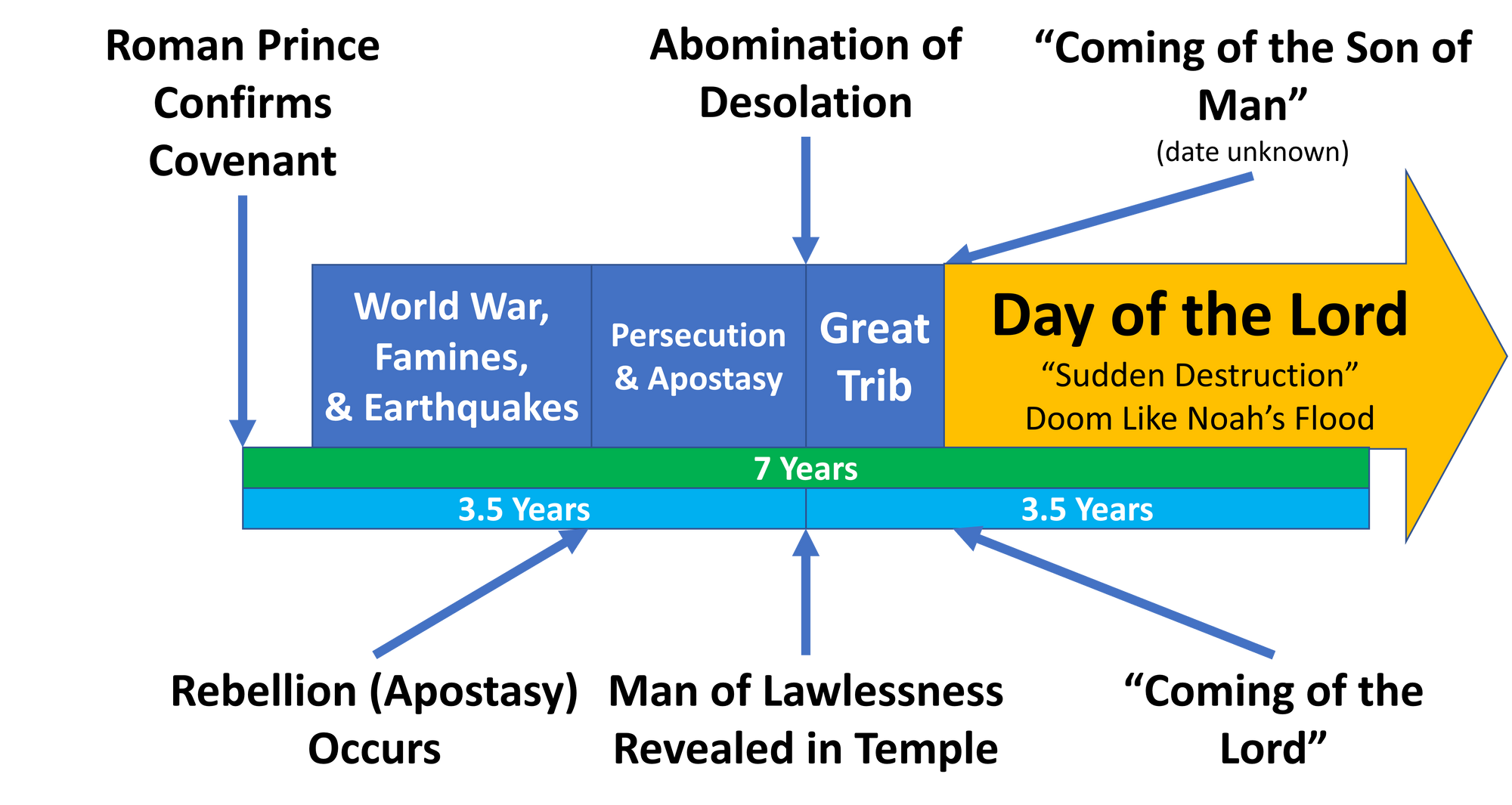
Who is the Restrainer?
Who is the “restrainer” that holds back the Antichrist? We cannot say for sure, since Paul does not identify him. However, there are numerous possibilities proposed by commentators:
- The Roman Empire and/or human governments
- The spreading of the gospel
- The Holy Spirit generally (or by his presence in the world via the Church)
- Michael the Archangel (9)
Some argue that the restrainer is Michael the archangel. In Daniel 12, Michael the archangel will “arise.” After he arises, the great tribulation begins. The word for “arise” means to stand up. Advocates of this view point to other usages of this word that may imply standing up, in the sense of refraining or desisting from doing something. Furthermore, Satan is thrown from heaven after a war with Michael the Archangel, described in Revelation 12. It is only then does the beast begin his reign for 3 1/2 years. (10)
Whoever the restrainer is, his removal cannot entail the Rapture of the Church. In two places, Paul equates the "day of the Lord" with the Rapture. Yet in 2 Thessalonians 2, Paul says that the day of the Lord (Rapture) does not happen until the man of lawlessness is revealed in the temple. If the Holy Spirit view was correct, then Paul would be effectively saying that "the day of the Lord (Rapture) cannot come unless the day of the Lord (Rapture) comes and then the man of lawlessness is revealed." This is obviously contradictory.
Furthermore, even if the Holy Spirit view was correct, it would at best prove a Mid-Trib Rapture. The man of lawlessness is revealed when he declares himself God in the temple. This is the same as the abomination of desolation, which happens halfway through the Antichrist's 7-year treaty . Therefore, the Holy Spirit's removal via Rapture of the Church would be a Mid-Trib event, not a Pre-Trib event.
Revelation Timeline
The book of Joel tells us another sign that must come before the Day of the Lord:
The sun shall be turned to darkness, and the moon to blood, before the great and awesome day of the Lord comes. (Joel 2:31)
Since these signs in the heavens are so dramatic, we might expect to see them mentioned in the book of Revelation. Yet we do, in chapter 6:
When he opened the sixth seal, I looked, and behold, there was a great earthquake, and the sun became black as sackcloth, the full moon became like blood, and the stars of the sky fell to the earth as the fig tree sheds its winter fruit when shaken by a gale. The sky vanished like a scroll that is being rolled up, and every mountain and island was removed from its place. Then the kings of the earth and the great ones and the generals and the rich and the powerful, and everyone, slave and free, hid themselves in the caves and among the rocks of the mountains, calling to the mountains and rocks, “Fall on us and hide us from the face of him who is seated on the throne, and from the wrath of the Lamb, for the great day of their wrath has come, and who can stand?” (Revelation 6:12-17)
Upon reflection, the opening of the 6th Seal, and the subsequent events, are very similar to how Jesus describes the coming of the Son of Man
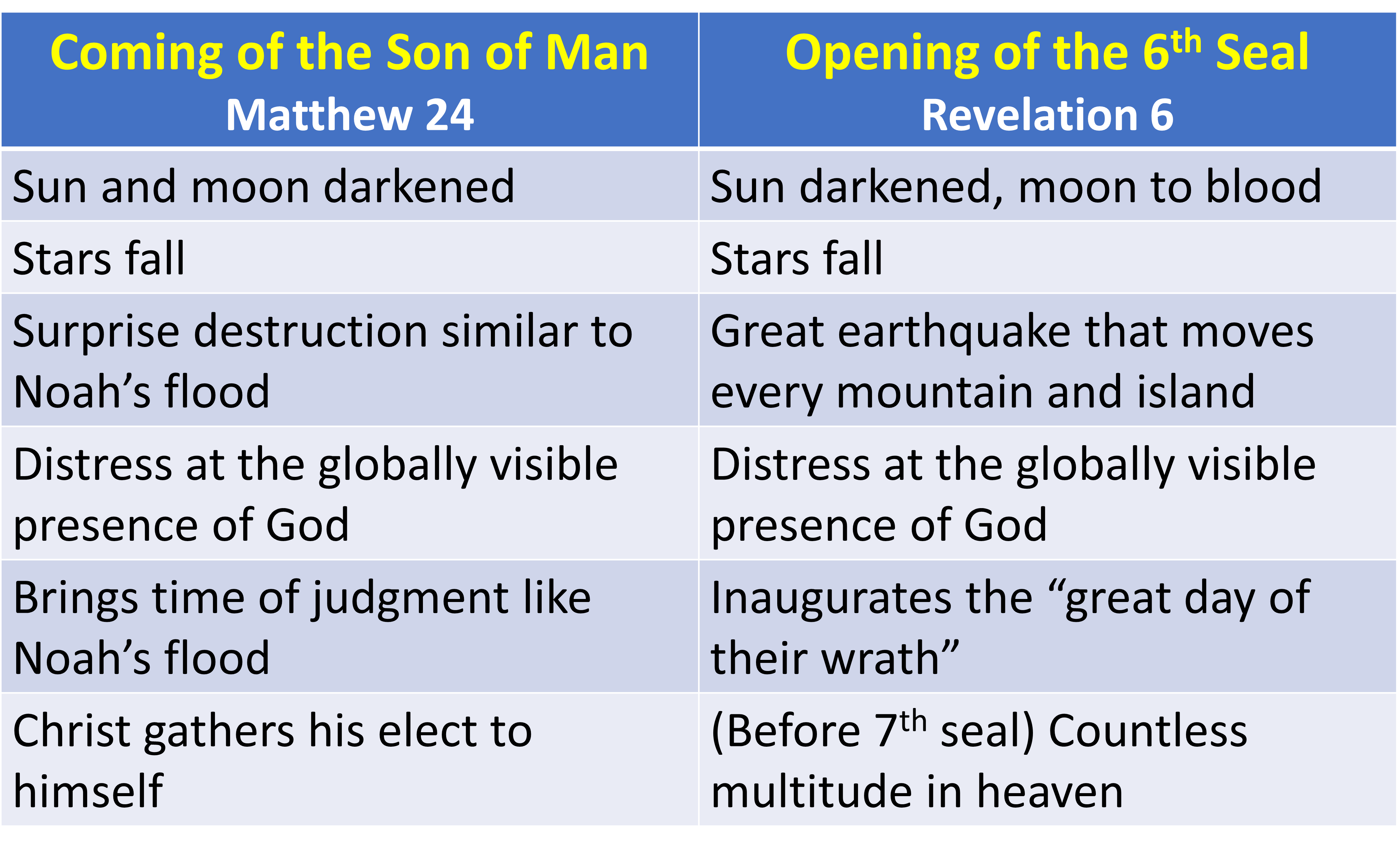
Yet the similarities are even more comprehensive. The signs leading up to the opening of the 6th Seal have a very strong correlation to the signs of the coming of the Son of Man in Matthew 24:
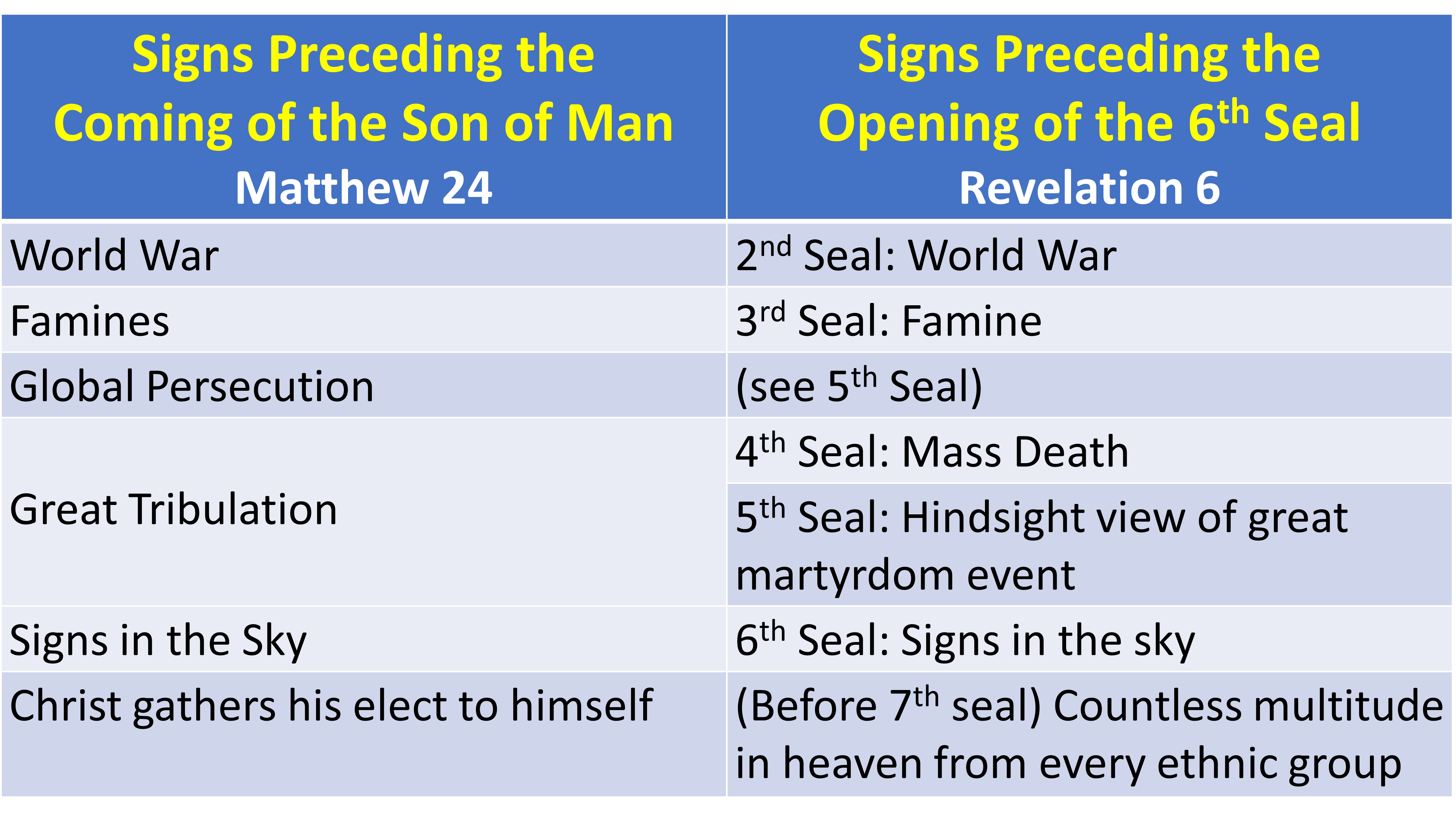
God's Wrath?
Are the first five Seals the wrath of God? Many believe so. There is a symmetry in the Seven Seals, Seven Trumpets, and Seven Bowls found in Revelation. Furthermore, Jesus himself opens the Seven Seals. However, a few observations show that the first five Seals are not God's wrath.
1st Seal: At the opening of the first Seal, the Antichrist rides out on a white horse, conquering without bloodshed. (Rev. 6:1-2) If this is a judgment of God, it is unclear who is being punished.
Seals 2- 4: War, famine and plague have not usually been instruments of God's wrath after the First Coming of Christ. Historically, God has used these to bring punishment on rebellious nations. Yet generally speaking, they are not punishments. They are indiscriminate in who they affect and have very natural causes. Contrast this with the Seven Trumpets and Seven Bowls, where specific angels usually cause supernatural harm to the environment and to the unrepentant world (Rev. 7-9;16).
5th Seal: The opening of the 5th Seal shows martyrs under the altar.
When he opened the fifth seal, I saw under the altar the souls of those who had been slain for the word of God and for the witness they had borne. They cried out with a loud voice, “O Sovereign Lord, holy and true, how long before you will judge and avenge our blood on those who dwell on the earth?” Then they were each given a white robe and told to rest a little longer, until the number of their fellow servants and their brothers should be complete, who were to be killed as they themselves had been. (Revelation 6:9-11)
Granted, the seal does not directly cause martyrdom. Even so, it would be strange to view this scene of martyrs under the altar as somehow representing part of God's wrath. Judgment and wrath usually happens in response to persecution (2 Thess. 1:5-7; Rev. 6: 9-17; Rev. 16: 4-6; Rev.18:20). It is not the persecution itself.
The strongest argument against the first five Seals being God's wrath is found here as well.
At the opening of the 5th Seal, believers cry out to God for payback against those who killed them. However, God does not immediately grant this, but tells them to wait a while longer. If God's wrath had been in progress, he would have told them he was working on it. He would not have told them to wait. When God's judgment is given against an adversary, God's people in heaven act very triumphant and happy (Revelation 19:1-2). But here, the dead are anxiously waiting for the score to be settled.
6th Seal: At the opening of the 6th Seal, the text explicitly states that God's wrath has arrived. The earth dwellers say that the "great day of their wrath has come, and who can stand?" At the 5th Seal, we see the prayer of the martyred saints for justice. In the 6th Seal, we see the answer to that prayer.
Jesus Christ opens the Seals of the scroll. As God incarnate, he is sovereign over all aspects of history. However, in the first five Seals, he is sovereign over historical events that are not God's wrath.
Great Multitude
Before the opening of the 7th Seal, a great multitude is seen in heaven from every ethnic group. They are rejoicing at the "salvation" of God, almost as if they just got rescued from something.
After this I looked, and behold, a great multitude that no one could number, from every nation, from all tribes and peoples and languages, standing before the throne and before the Lamb, clothed in white robes, with palm branches in their hands, and crying out with a loud voice, “Salvation belongs to our God who sits on the throne, and to the Lamb!” And all the angels were standing around the throne and around the elders and the four living creatures, and they fell on their faces before the throne and worshiped God, saying, “Amen! Blessing and glory and wisdom and thanksgiving and honor and power and might be to our God forever and ever! Amen.” (Revelation 7:9-12)
They are no longer in the distressed state as they were when they were souls under the altar, longing for the justice of God.
One of the 24 elders tells John who these people are:
Then one of the elders addressed me, saying, “Who are these, clothed in white robes, and from where have they come?” I said to him, “Sir, you know.” And he said to me, “These are the ones coming out of the great tribulation. They have washed their robes and made them white in the blood of the Lamb. (Revelation 7:13-14)
This is very consistent with the Rapture view presented here. The believers are suddenly rescued, via the Rapture, immediately after the Great Tribulation. This also sounds a lot like Daniel 12:
At that time shall arise Michael, the great prince who has charge of your people. And there shall be a time of trouble, such as never has been since there was a nation till that time. But at that time your people shall be delivered, everyone whose name shall be found written in the book. And many of those who sleep in the dust of the earth shall awake, some to everlasting life, and some to shame and everlasting contempt. (Daniel 12:1-2)
Are these resurrected saints, or the martyred dead in discussed previously Revelation 6? Some theologians teach that this multitude is a large group of martyrs that enter heaven during the Great Tribulation. They support this view by noting that each of the martyred dead receive a "white robe" (Rev. 6:11) prior to this. The multitude in Revelation 7 also wear "white robes" (Rev. 7:13).
Yet Revelation 7 gives clues that these are physically resurrected saints:
Therefore they are before the throne of God, and serve him day and night in his temple; and he who sits on the throne will shelter them with his presence. They shall hunger no more, neither thirst anymore; the sun shall not strike them, nor any scorching heat. For the Lamb in the midst of the throne will be their shepherd, and he will guide them to springs of living water, and God will wipe away every tear from their eyes. (Revelation 7:15-18)
The mention of physical provision and protection implies that the saints now have physical bodies. Granted, this could technically apply to martyrs as well. However, the physical descriptions are more suitable for someone who is resurrected. Furthermore, the sudden attitude change and rejoicing at "salvation" is more suited for the Rapture having just happened. As Paul says:
For God has not destined us for wrath, but to obtain salvation through our Lord Jesus Christ, who died for us so that whether we are awake or asleep we might live with him. (1 Thess 5:9-10)
The author of Hebrews also supports this point, saying:
so Christ, having been offered once to bear the sins of many, will appear a second time, not to deal with sin but to save those who are eagerly waiting for him. (Hebrews 9:28)
This leads us to this timeline, superimposing Jesus onto Revelation:
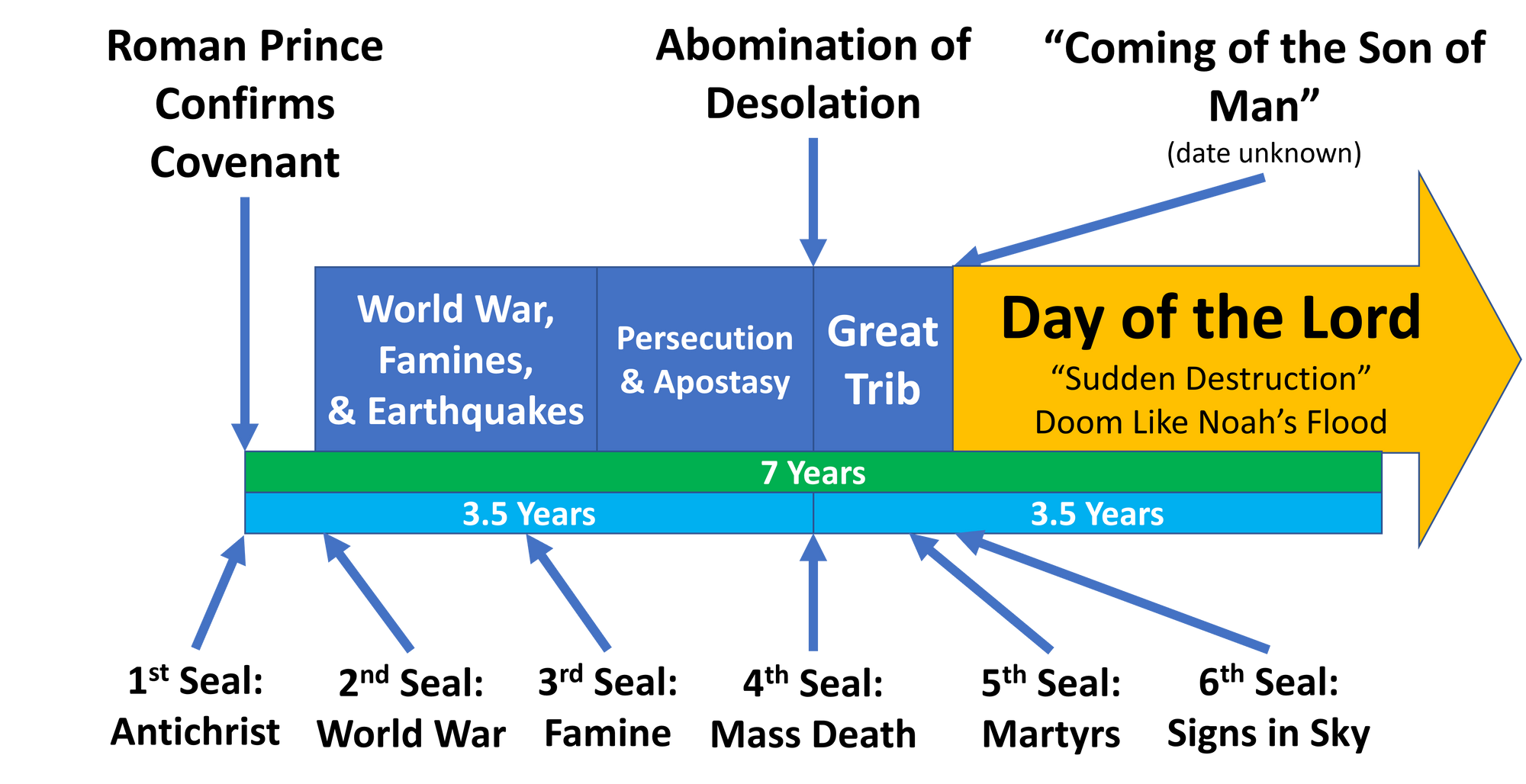
The 7th Trumpet
You may be wondering why the "Day of the Lord" arrow extends past the reign of Christ in Jerusalem. The 6th Seal explicitly launches God's wrath. This leaves the remaining judgments:
- Final seal is opened
- Seven Trumpets
- Seven Bowls
When does Christ sit on the throne in Jerusalem? When the 7th Trumpet is blown, the kingdom of the world becomes the kingdom of the Lord.
Then the seventh angel blew his trumpet, and there were loud voices in heaven, saying, “The kingdom of the world has become the kingdom of our Lord and of his Christ, and he shall reign forever and ever.” And the twenty-four elders who sit on their thrones before God fell on their faces and worshiped God, saying,
“We give thanks to you, Lord God Almighty, who is and who was, for you have taken your great power and begun to reign. The nations raged, but your wrath came, and the time for the dead to be judged, and for rewarding your servants, the prophets and saints, and those who fear your name, both small and great, and for destroying the destroyers of the earth.” (Revelation 11: 15-18)
Some may object, saying that seven Bowl Judgments must happen within the 7 years as well. However, the final seven years in Daniel 9:27 apply to "your people and your holy city," that is, the Jews and Jerusalem. Jesus must be reigning from Jerusalem by the end of the 7 years. It does not mean all of his enemies are conquered.
This idea is supported by one of the bowl judgments as well, pertaining to the beast. In Revelation 13, the beast was described as a global power, having dominion over everyone on the face of the earth.
Also it was allowed to make war on the saints and to conquer them. And authority was given it over every tribe and people and language and nation, and all who dwell on earth will worship it, everyone whose name has not been written before the foundation of the world in the book of life of the Lamb who was slain. (Revelation 13:7-8)
However, the fifth bowl judgment implies that the beast is now merely a regional power.
The fifth angel poured out his bowl on the throne of the beast, and its kingdom was plunged into darkness. People gnawed their tongues in anguish and cursed the God of heaven for their pain and sores. They did not repent of their deeds. (Revelation 16:10-11)
If the beast is a regional power, then who replaced his global dominion? Jesus did. (Rev. 11:15) During the bowl judgments, Jesus is reigning from Jerusalem. Yet the beast still has a regional holdout, and is later defeated at the Battle of Armageddon.
Conclusion
Which leads us to our final timeline. Here you will note the relatively short time for the bowl judgments prior to the Millennium. This extra space can be accounted for with the different time frames found in Daniel 12:11, which are slightly greater than 3 1/2 years.
And from the time that the regular burnt offering is taken away and the abomination that makes desolate is set up, there shall be 1,290 days. Blessed is he who waits and arrives at the 1,335 days. (Daniel 12:11)
A full discussion of these numbers is outside the scope of this article. However, they allow us some leeway for an extra time gap before the Millennium, to accommodate the bowl judgments.
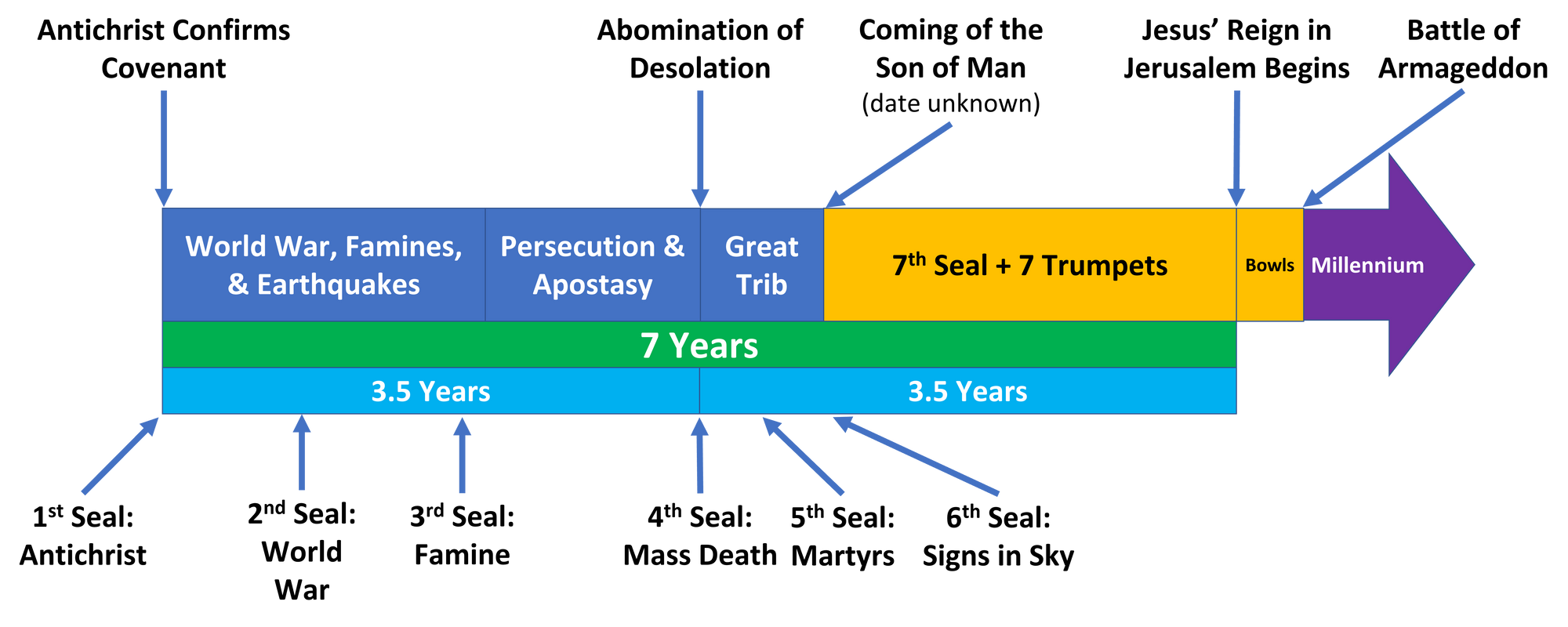
This article was an explanation of the Pre-Wrath Rapture of the Church. This places the coming of the Son of Man at an unspecified day and hour after the start of the Great Tribulation. The believers are rescued to heaven via the Rapture. However, unbelievers are left to face the visible wrath of God, in the time period known as the "Day of the Lord." This eventually culminates in the enthronement of Christ in Jerusalem, the defeat of the Antichrist, and the start of the Millennium.
End Notes:
- Rosenthal, Marvin. Prewrath Rapture of the Church. 2nd ed. Nashville, TN: Thomas Nelson, 1990.
- Ginzberg, Louis. "JewishEncyclopedia.com." ABOMINATION OF DESOLATION - JewishEncyclopedia.com. Accessed November 2, 2018. http://www.jewishencyclopedia.com/articles/353-abomination-of-desolation.
- MacArthur, John. "The Abomination of Desolation." Grace to You. October 16, 2017. Accessed November 2, 2018. http://www.gty.org/library/bibleqnas-library/QA0093/the-abomination-of-desolation.
- Price, Randall. "Abomination of Desolation :: By Randall Price (PDF)." Rapture Ready. January 24, 2017. Accessed November 2, 2018. http://www.raptureready.com/2015/04/07/abomination-of-desolation-by-randall-price-pdf.
- Ice, Thomas. "Part 13 - Matthew 24:15 The Abomination of Desolation by Thomas Ice." Blue Letter Bible. Accessed November 2, 2018. https://www.blueletterbible.org/Comm/ice_thomas/Mat24-25/Mat24-25_Part13.cfm.
- Zuck, Roy B., and John F. Walvoord. The Bible Knowledge Commentary: An Exposition of the Scriptures by Dallas Seminary Faculty: Old Testament. Wheaton, IL: Victor Books, 1985.
- "Contraction Timer & Calculator For Labor Pains." MomJunction. Accessed November 2, 2018. http://www.momjunction.com/contraction-calculator/.
- "Strong's Greek: 646. ἀποστασία (apostasia) -- Defection, Revolt." Bible Hub. Accessed November 2, 2018. https://biblehub.com/greek/646.htm.
- MacArthur, John. "The Coming Man of Sin, Part 4." Grace to You. April 12, 1992. Accessed November 2, 2018. https://www.gty.org/library/sermons-library/53-10.
- Kurschner, Alan E. "6 Reasons Why Michael Is the Restrainer." ESCHATOS MINISTRIES. March 16, 2018. Accessed November 2, 2018. https://www.alankurschner.com/2017/03/24/6-reasons-why-michael-is-the-restrainer/.
- “Scripture quotations are from The ESV® Bible (The Holy Bible, English Standard Version®), copyright © 2001 by Crossway, a publishing ministry of Good News Publishers. Used by permission. All rights reserved.”
Photo Credits:
- Vidal, Fernando. Wikimedia Commons. August 31, 2011. Accessed February 7, 2019. https://commons.wikimedia.org/wiki/File:Fernando_Vidal_19_(6127317082).jpg.
